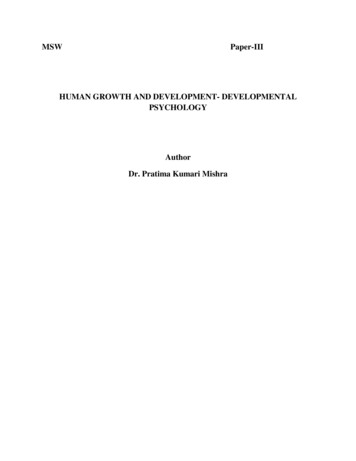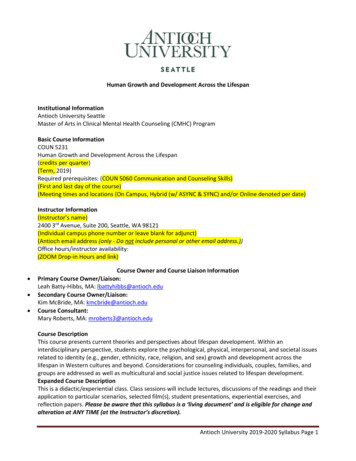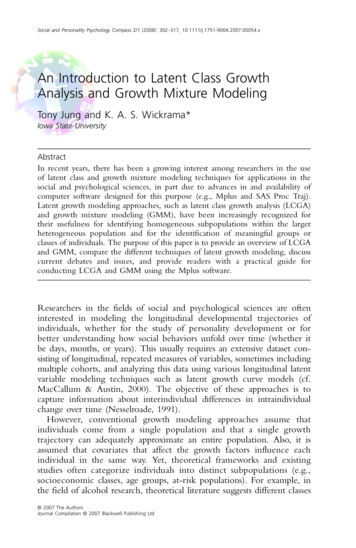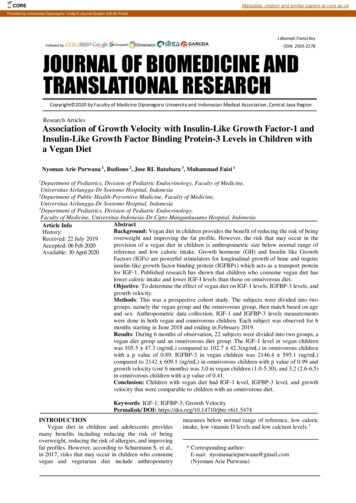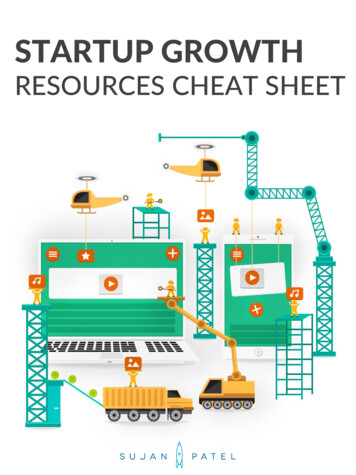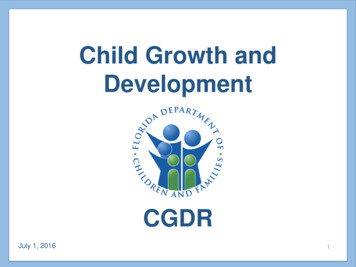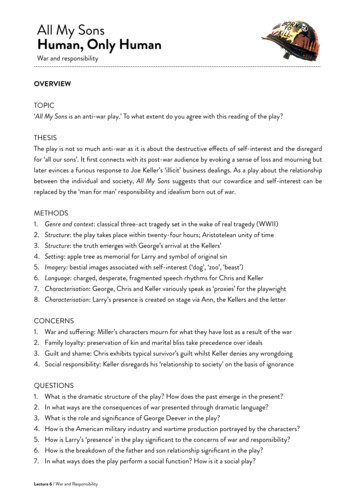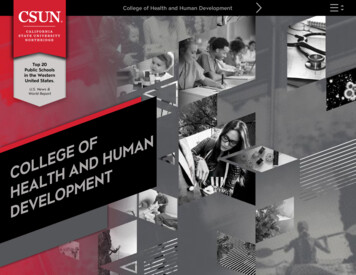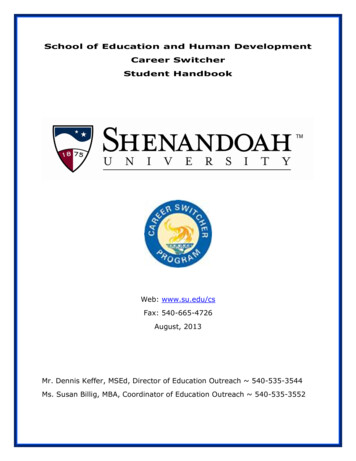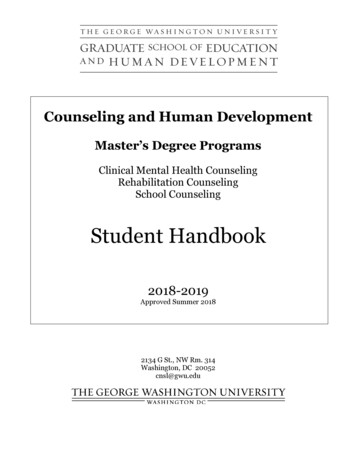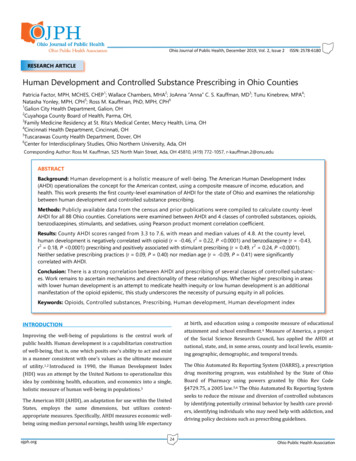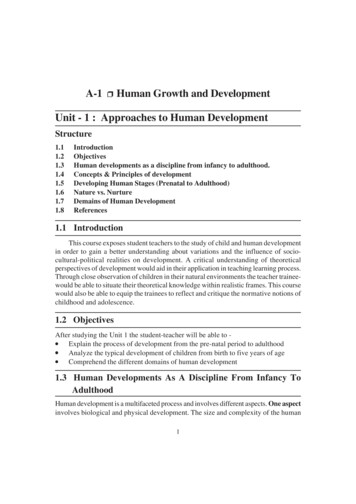
Transcription
A-1 Human Growth and DevelopmentUnit - 1 : Approaches to Human uctionObjectivesHuman developments as a discipline from infancy to adulthood.Concepts & Principles of developmentDeveloping Human Stages (Prenatal to Adulthood)Nature vs. NurtureDemains of Human DevelopmentReferences1.1 IntroductionThis course exposes student teachers to the study of child and human developmentin order to gain a better understanding about variations and the influence of sociocultural-political realities on development. A critical understanding of theoreticalperspectives of development would aid in their application in teaching learning process.Through close observation of children in their natural environments the teacher traineewould be able to situate their theoretical knowledge within realistic frames. This coursewould also be able to equip the trainees to reflect and critique the normative notions ofchildhood and adolescence.1.2 ObjectivesAfter studying the Unit 1 the student-teacher will be able to Explain the process of development from the pre-natal period to adulthood Analyze the typical development of children from birth to five years of age Comprehend the different domains of human development1.3 Human Developments As A Discipline From Infancy ToAdulthoodHuman development is a multifaceted process and involves different aspects. One aspectinvolves biological and physical development. The size and complexity of the human1
body change dramatically between conception and maturity.Another aspect involves cognitive or intellectual abilities and processes. What childrenknow, learn and can remember changes greatly as they grow with the time.A third aspect involves social behavior and relationships. A newborn has limited abilityto participate in social interactions but before reaching adulthood the child forms manyrelationships and knows how to behave appropriately in a variety of social situations.All the different facets of development are inter related.Child development is the scientific study of how and why children change over time.Although development is a continuous process it can be broadly divided into five periodsa. The prenatal period - Conception to birthb. Infancy and toddlerhood -Birth to age 3c. The preschool period -Ages 3 to 6d. Middle childhood / the school years - Ages 6 to 12e. Adolescence - Age 12 to adulthoodInfluences on Development: What Makes Change Occur?Each child inherits certain genetic potential from the parents. Although the gene set thelimits for particular behavior, it is the environment that determines where within thoselimits the behavior will be expressed. Major environmental influences include :i. Culture-the impact of Indian valuesii. Raceiii. Social class - the influence of wealth, poverty, middle-class statusiv. Ethnicity-the impact of common language, religion, or national originv. Key people in the child’s life - parents, peers, relatives, heroes and others whoexert a powerful influence,vi. The media - information and attitudes conveyed to children on TV, over the radio,andthrough books, magazines, newspapers, records, tapes and CDsvii. Unpredictable life events - the unexpected turns ( sudden wealth or poverty, theloss of a parent, sudden disability and other factors) in life can alter the course ofthe child’s lifeStages of Prenatal DevelopmentThe word prenatal literally means ‘before birth’. It is now recognized that the prenatalorganism is vulnerable to a variety of factors that can influence the course of itsdevelopment. This period is extremely important as the periods of prenatal development2
undergoes a systematic series of sequential changes to become increasingly complexand differentiated.Over the period of the ten lunar months (usually about 280 days) of prenatal development,the new organism shows many varieties of change. Changes in the kinds, number,position, size and shapes of cells, tissues, and somatic systems occur.Prenatal development includes three periods and these periods are a continuous phaseof development:The period of the zygote / period of ovum, which is sometimes called the germinalperiod, includes approximately the first two weeks of life, extending from fertilizationuntil the fertilized ovum, or zygote, proceeds down the fallopian tube and becomesimplanted on the wall of the uterus.The period of the embryo extends from the second gestational week to the end of theeighth gestational week. After implantation, the developing baby is called an embryo.Differentiation of the most important organs and physiological systems occurs at thistime, and by the end of this period, the embryo is recognizable as a partially functioningtiny human being. The period of the embryo is the phase in which environmentalintrusions caused by such things as maternal disease, malnutrition and drugs, etc., mayresult in deviations in development. In addition, in this period, three important supportingstructures develop - the amniotic sac, the placenta and the umbilical cord. By the endof the period of embryo, the face and its features are delineated, and fingers, toes andexternal genitalia are present. At 6 weeks the embryo can be recognized as a humanbeing, although a rather strangely proportioned one in that the head is almost as largeas the rest of the body. Primitive functioning of the heart and liver, as well as theperistaltic movement of ingestion, has been reported late in this period. Mostmiscarriages, or spontaneous abortions, occur during this period; the embryo becomesdetached from the wall of the uterus and is expelled. Research has shown that the rateof spontaneous abortion is as high as 1 in 4 pregnancies. This high rate of abortion maybe advantageous to the species since the great majority of aborted embryos have grosschromosomal and genetic disorders. The most severely affected embryos arespontaneously eliminated.The period of the fetus extends from the ninth gestational week to birth. During thistime the body systems developed within the first 8 weeks of life are improved andperfected (O’Rahilly and Muller,1987). The central nervous system (CMS developsrapidly in this period though the development of CNS is completed several years afterbirth. By the end of the fourth month (usually between 14th and 20th week) mothersusually report movement of the fetus, This event is called quickening (A. C Harris,1993), it marks the first direct contact between the mother and the baby. At around 5months reflexes such as sucking, swallowing and hiccoughing usually appear. After3
the fifth month the fetus develops nails and sweat glands, a coarser, more adult likeskin, and a soft hair which covers the body. By 6 months the eyes develop, and openingand closing of the eyes occur. If an infant is born prematurely at 6 months, the regulatoryprocesses and respiratory systems are usually not mature enough for survival withoutintensive intervention.Prenatal Influences on DevelopmentDuring the period of prenatal development many agents may raise the incidence ofdeviations or produce malformations in the fetus. These agents are called teratogens,which derives from the Greek word ‘teras’, meaning ‘monster’ or ‘marvel’. Teratologyis the study of environmental factors that affect prenatal growth and cause birth defects(Moore,1989).Six classes of teratogens have been identified that account for 10% or fewer of allcongenital malformations {Brent & Beckman, 1990)1.Disease or illness in the mother - hypertension (high blood pressure), diabetes,eclampsia (a type of hypertension), Rubella, chicken pox, mumps and measles(caused by viruses), toxoplasmosis (infected animals may pass the parasite, or itmay be present in the raw meat eaten by animals), Sexually transmitted diseases(syphilis, AIDS,etc), Blood (Rh) incompatibility.2.Prescription and social drugs :-laxatives, tranquilizers, diet pills, headache andcold remedies, antacids and even aspirin can have complicating effects. Steroidsmay have devastating consequences for fertility for both men and women. Illegaldrugs, e.g., cocaine, heroin, morphine and other addictive drugs, cigarette smoking,alcohol use.Nutritional deficits and inconsistenciesStress and emotional factorsRadiation exposureChemicals, toxins, and pollutants3.4.5.6.1.4 Concepts and Principles of DevelopmentDevelopment refers to change through time but not all changes are developmental.Developmental changes are systematic rather than haphazard and successive ratherthan independent of earlier conditions. Werner (1957) suggested that changes areconsidered as developmental when they are from a global form of organization to amore differentiated and complex form.4
Knowledge of the pattern of human development helps to know what to expectfrom children, at (approximately) what ages to expect different patterns of behaviorto appear and when these patterns will normally be replaced by more maturepatterns. This understanding is important so that we can expect from a childaccordingly, in relation to the norms of her/his age group. If we expect too muchthe child may develop a feeling of inadequacy or if we expect little then they aredeprived of incentives to develop their potentials. The pattern of development for all typically developed children is approximatelythe same, so it is easy to evaluate each child in relation to the norms of her/his agegroup. The typically developed children may make adjustments to socialexpectations. But the children who deviate from the normal pattern may improvewith help, opportunities and motivation. Knowledge about the pattern of normal development may facilitate the parents andteachers to guide, provide opportunities and encouragement for the delayed children. Growth and DevelopmentMany people use the terms ‘growth’ and ‘development’ interchangeably. In reality theyare inseparable and neither takes place alone.GrowthDevelopment Growth refers to quantitative changes(physical) - increase in structure and size Development refers to both qualitativeand quantitative changes Size and structure of the internaland functions organs and the brainincreasesGrowth can be measured with somedegree of reliability in terms of weight,bone age , etc. Development involves both structureThe child grows mentally as well aslead forward physically. Progressive signifies that the changes Development may be defined as aprogressive series of orderly, coherentchanges Orderly and coherent indicates thatthere is a definite relationship betweenthe changes that are taking place andthose that preceded or will follow them Development is a continuous processthat starts even before birth Numerous and simultaneousprogressions of development areclosely related and manifest manyindividual variations i.e.5
Principles of Growth Cephalocaudal Principal: growth directs the development from the head downward Proximodistal Principal: growth that proceeds from the spine to the extremities i.e.encourages development from the central part of the body outward.1.5 Developing Human–Stages (Prenatal to Adulthood)Typical Major Developments in Eight Periods of Life SpanAge PeriodPhysical DevelopmentCognitive DevelopmentPrenatalConception occursØ Abilities to learn andPeriodØ The genetic endowmentremember, and to(conception tointeracts withrespond to sensorybirth)environmental influencesstimuli, arefrom the beginning.developingØ Basic body structures andorgans form.Ø Brain growth spurt begins.Ø Physical growth is the mostrapid in the life span.Ø Vulnerability toenvironmental influences isgreat.Infancy andToddlerhood(birth to age3)PsychosocialDevelopmentØ Fetus responds tomother’s voice anddevelops a preference for it.Ø All senses and bodysystems operate at birth tovarying degrees.Ø Ability to learn andØ Attachments toparents and othersremember are present,form.even in early weeks.Ø The brain grows incomplexity and is highlysensitive to environmentalinfluence.Ø Use of symbols andability to solveproblems develop byend of second year.Ø Physical growth anddevelopment of motor skillsare rapid.Ø Comprehension anduse of languagedevelop rapidly.6Ø Self-awarenessdevelops.Ø Shift from dependence to autonomyoccurs.Ø Interest in otherchildren increases.
Early Childhood (3 to 6years)Ø Growth is steady:appearance becomesmore slender andproportions more adultlike.Ø Appetite diminishes, andsleep problems arecommon.Handedness appears; fineand gross motor skillsand strength improve.Ø Thinking is somewhat egocentric,but understandingof other people’sperspectives grows.Ø Cognitiveimmaturity leads tosome illogical ideasabout the world.Ø Memory andlanguage improve.Ø Intelligencebecomes morepredictable.Ø Attendingpreschool iscommon,kindergarten moreso.Ø Self-concept andunderstanding ofemotions grow:self-esteem isglobal. Independence, initiative/self-control, andself-care increase.Ø Gender identitydevelops.Ø Play becomes moreimaginative, moreelaborate, and moresocial.Ø Altruism,aggression, andfearfulness arecommon.Ø Family is still focusof social life, butother childrenbecome moreimportant.Middle Childhood (6 to 11years)Ø Growth Slows.Ø Strength and athleticskills improve.Ø Respiratory illnesses arecommon, but health isgenerally better than atany other time in lifespan.Ø Egocentrismdiminishes.Children begin tothink logically butconcretely.Ø Memory andLanguage skillsincrease.Ø Cognitive gainspermit children tobenefit from formalschooling.Ø Some childrenshow specialeducational needsand strengths.Ø Self conceptbecomes morecomplex, affectingself-esteem.Ø Co-regulationreflects gradualshift in controlfrom parents tochild.Ø Peers assumecentral importanceAdolescence (11to about 20years)Ø Physical growth andother changes are rapidand profound.Ø Reproductive maturityoccurs.Ø Major health risks ariseØ Ability to thinkabstractly andscientific reasoningdevelops.Ø Immature thinkingpersists in someØ Search for identity,including sexualidentity, becomescentral.Ø Relationships withparents are7
from behavioral issues,such as eating disordersand drug abuse.Young Adulthood(20 to 40 years)Middle Adulthood (40 to 65years)Late Childhood(65 years andabove)attitudes andbehaviors.Ø Education focuseson preparation forcollege or vocation.generally good.Ø Peer groups helpdevelop and testself-concept butalso may exert anantisocial influence.Ø Cognitive abilitiesand moral judgmentsassume morecomplexity.Ø Educational andcareer choices aremade.Ø Personality traitand styles becomerelatively stable,but changes inpersonality maybeinfluenced by lifestages and events.Ø Decision are madeabout intimaterelationships andpersonal lifestyles.Ø Most people marry,and most becomeparents.Ø Sense of identitycontinues todevelop; stressfulmidlife tractionmay occur.Ø Doubleresponsibilities ofcaring for childrenand elderly parentsmay cause stress.Ø Physical conditionpeaks, then declinesslightly.Ø Lifestyle choicesinfluence health.Ø Some deterioration ofsensory abilities, health,stamina, and skills maytake place.Ø Women experiencemenopause.Ø Most basic mentalabilities peak; expertise and practicalproblem solving skillsare high.Ø Creative output maydecline but improvein quality.Ø For some, careersuccess and earningpowers peak; forothers, burnout orcareer change mayoccur.Ø Most people are healthy Ø Most people areand active althoughmentally alert.health and physicalØ Althoughabilities declineintelligence andsomewhat.memory mayØ Slowing of reaction timedeteriorate in someaffects some aspects ofareas, most peoplefunctioning.find ways tocompensate.8Ø Retirement fromworkforce mayoffer new optionsfor use of time.Ø People need tocope with personallosses andimpending death.Relationship withfamily and closefriends can provideimportant support.Search for meaningin life assumescentral importance.
1.6 Nature Vs NurturePsychologists considers that day to day behavior is affected by both biology andenvironment and by past as well as by current experiences. People’s moods and thoughtsare often the result of genetic factors and biochemical processes interacting withenvironment. There is a complex interplay between experience and biology, betweenconscious voluntary decision making and inherited traits - between nurture and nature.Nurture refers to the impact of learning, training, education or more generally theindividual’s environment.Nature refers to the impact of an individual’s genetic inheritance or heredity. But inheritedtraits do not become evident in behavior unless a person’s environment supports andencourages them. Thus a child who has inherited some special talent must be givenopportunitiesSome influences on development originate primarily with heredity: the geneticendowment inherited from a person’s biological parents at conception. Other influencescome from the inner and outer environment: the world outside the self-beginning in thewomb, and the learning that comes from experience. Individual differences increase aspeople grow older. Many typical changes of infancy and early childhood seem to betied to maturation of the body and brain - the unfolding of a natural sequence of physicalchanges and behavior patterns, including readiness to master new abilities such aswalking and talking. As children grow into adolescents and then into adults, differencesin innate characteristics and life experience play a greater role.Many controversies about children’s development rest upon differences in the emphasisplaced on nature and nurture as explanations for development. One of the controversiesconcerns the relative importance of heredity and environment in determining the physicaland mental characteristics of the developing child. No completely accepted methodhas been formed to isolate the influence of heredity from that of environment.The evidence indicates that the development of physical and mental traits comes partlyfrom exercise and effort on the part of the individual. Which plays the more importantrole is still a matter of conjecture.Intrinsic maturation is the unfolding of characteristics potentially present in the individualthat come from the individual’s genetic endowment. The common development suchas creeping, crawling, sitting and walking comes through maturation.The functions specific to the individual such as swimming, ball throwing, riding bicycles9
or writing need training. Without training the said skills may not develop. No hereditaryendowment can mature fully without environmental support.In the field of child development Both biological and environmental factors are influential Biological extremists argue that biology is destiny and development is maturation,course of development is predestined and predetermined by genetic factors. Modern developmental psychologists are exploring, how biological andenvironmental factors interact to produce developmental differences.1.7 Domains of Human DevelopmentTo understand the similarities and differences in development we need to look at differentDomains of human development. The domains can be categorized under three majordirections such as Physical Development (Organized as motor development and posture and largemovements) Cognitive Development Psycho-social DevelopmentThe following illustrations can provide a starting point for prompting age-appropriateinformation for making observations and for obtaining a comparative view of the child’sachievments against the average expected achievments: i.e. typical developmentalprogress. These will provide information and sequence of development and key stageswithin each domain.PHYSICAL DEVELOPMENT (Organized as motor development and posture andlarge movements)The progress in motor development is the result of an on going bi-directional interactionbetween maturation and experience, which results in a continuously self-organisingdynamic system. (Thelen,1995)The influences of motor development:Biologically dependent neural maturation consist ofi)Maturing muscle tone and muscle strength10
ii) Improving balance and co-ordinationiii) Developing information processing abilitiesExperience - ongoing action perception cycle consist ofi)Perceiving possibilities and self-capabilitiesii) Interaction with other domains such as motivation, social and cognitive developmentiii) Specific and flexible learningConditions that influence the Rate of Motor Developmenta) Genetic constitution which includes body build and intellectual levelb) Favourable pre-natal conditions, e.g. maternal nutritionc) Intellectual leveld) Stimulatione) First born ahead of others (parental encouragement)f) Sex, race and socio-economic differencesPhases of Motor DevelopmentBirth - 4 months Primitive reflex movements4 months- 1 year Inhibition of primitive reflexes by 6 months Improving muscle tone with reducing flexor muscle tone in thelimbs and improving extensor tone in the trunk Improving postural control and balance Movements become differentiated and functional, such asreaching, grasping, sitting, walking1-2 years2-7 years Better differentiated and more precise movements Improving stability and power Maturing functional movements such as running, jumping,catching, throwing, writing, cutting Improved rhythm, sequences, integration and flow to achieveefficient, co-ordinated and controlled performance in day to dayactivities7 years onwards Applying motor skills to specialized activities of sportsand work11
POSTURE AND LARGE MOVEMENTS (Major development)AGE 1 MONTH Lying on back (supine) keeps head to one side Jerky movements of limbs and arms than legs At rest keeps hands closed and thumbs turned in Fingers and toes fan out in extension of limbs Pulled to sit - head lags till vertical , then momentarily erect, back is one completecurve Held in supported sitting In ventral suspension- holds head in line with body and hips are semi-extended Placed on abdomen (prone)head immediately turns to side, arms and legs flexed,elbows away from body, buttocks moderately highAGE 3 MONTHS Lying on back (supine) - prefers to lie with head in midline, limbs more pliable,movements smoother and more continuous Waves arms symmetrically, hands loosely open Brings hands together from sides to midline over chest and chin Kicks vigorously, legs alternate or occasionally together When pulled to sit - little or no head lag Held sitting - back is straight except in lumbar region Head held erect and steady for several seconds before bobbing forwards In ventral suspension - head held well above line of body, hips and shouldersextended Needs support at shoulders when being bathed and dressed Lying on abdomen (prone) - lifts head and upper chest well up in midline, usingforearms to support with buttocks flat Held standing with feet on hard surface, sags at knees (negative support reflex)12
AGE 6 MONTHS In supine - raises head up and moves arms up to be lifted When hand grasped - braces shoulders and pulls self to sitting Kicks strongly, legs alternating Sits with support and turns head from side to side to look around Can roll over from prone to supine at around 5-6 months and usually from supineto prone at around 6-7 months (Bly, 1994) Held sitting - head firmly erected with back straight May sit alone momentarily In prone- lifts head and chest well up, supporting self on flattened palms andextended arms In supported standing with feet touching hard surface - bears weight on feet andbounces activelyAGE 9 MONTHS Sits unsupported 10-15 minutes on the floor Can lean forward and pick up toy without losing balance Can turn body to look sideways and grasps toy Very active movements of whole body Progresses on floor by rolling or squirming Attempts to crawl and sometimes succeeds Pulls to standing holding support for a few moments but cannot lower himself andfalls backwards with a bump Held in standing - steps purposefully on alternate feet When being carried by an adult, supports self in upright position and turns headtolook aroundAGE 12 MONTHS Sits well on floor for indefinite time Can rise to sitting position from lying down with ease13
Crawls, shuffles on buttocks or ‘bear walks’ rapidly Pulls to standing and sits down again holding onto furniture Walks around furniture lifting one foot and stepping sideways Walks forwards and sideways with one or both hands held May stancj for a few moments, may walk May crawl upstairs (average 13-14 months)AGE 15 MONTHS May walk alone usually with uneven steps: feet wide apart, arms slightly flexedand held above head or shoulder level for balance. Let’s self-down from standing to sitting by collapsing backward with a bump Kneelsunaided or with supportAGE 18 MONTHS Walks well with feet only slightly apart Starts and stops safely No longer needs to hold up arms in extension to balance Runs carefully, head held erect in midline, eyes on the ground but finds difficultyin negotiating obstacles Pushes or pulls toys or boxes Can carry a large doll or teddy bear while walking Backs into small chair or slides in sideways Climbs forward into adult’s chair, then turns around and sit Squats and rises with hands helping Walks upstairs with helping hand Creeps backwards down stairs or (occasionally) bumps down on buttocks Kneels upright on flat surface without support14
AGE 2 YEARS Runs safely on whole foot, stopping and starting with ease and avoiding obstacles Squats and rises to feet without using hands Pushes and pulls toys easily Walks backwards pulling toys Pulls small toys by cord with obvious appreciation of direction Climbs on furniture to look out of window or to open doors and can get downagain Shows increasing understanding of self in relation to size and position of objectsin the environment and to enclosed spaces such as a cupboard or cardboard box Walks up and down stairs holding on to rail or wall, two feet on each stair Throws small ball overhand and forwards without falling Walks into large balls when trying to kick it Sits on small tricycle but cannot use pedals - propels with feet across floorAGE 3 YEARS Walks alone up stairs using alternate feet, comes downtwo feet to a step Usually jumps from bottom step with two feet together Climbs nursery apparatus with agility Can turn around odstacles and corner while running and while pushing or pullingtoys Walks forwards, backwards sideways hauling large toys with complete confidence Obviously appreciates size and movements of own body in relation to externalspaces Rides tricycle using pedals and can steer round obstacles Can stand and walk on tiptoe Stands momentarily on one(preferred) foot when shown Sits with feet crossed at ankles Can throw ball overhead and can catch large ball on or between extended arms Kicks ball forcibly15
AGE 4 YEARS Walks or runs alone up and down stairs, one foot to each step Navigates self-locomotion skillfully, turning sharp corners, running, pushing andpulling Climbs ladders and trees Expert rider of tricycle, executing sharp U-turns easily Stands on one foot (preferred) for 3-5 seconds and hops on preferred foot Arranges and picks up objects from floor by bending from waist, with knees straight Sits with knees crossed Shows increasing skill in ball games, throwing, catching, bouncing, kicking, etc.,including use of batAGE 5 YEARS Walks easily on narrow line Runs lightly on toes Active and skillful in climbing, sliding, swinging, digging, and various ‘stunts’ Skips on alternate feet Moves rhythmically to music Grips strongly with either hand Can stand on one foot 8-10 seconds, right or left and also stand on preferred footwith arms folded Can hop 2 or 3 yards forward on each foot separately Can bend and touch toes without flexing knees Plays all varieties of ball games with considerable ability, including those requiringappropriate placement or scoring, according to accepted rulesCognitive DevelopmentAll children can learn. Learning refers to adaptation to one’s environment throughthe use of cognitive or intellectual development. Intellectual development can be16
defined as an individual’s ability to cope with the changing world through continuousorganization and re-organisation of experiences.Cognitive development refers to the processes involved in Attention - focuses on selection of sensory stimuli Perception - include detection, organization, interpretation of sensory information Memory - refers to retention and recall of perceived information Reasoning - using knowledge to make association between familiar and newinformation, make inferences and draw conclusions Reflection - evaluation of the quality of ideas and solutions to problems Insight - recognition of new relationships between two segments of informationLearning is facilitated by both the Internal and External environment.The Internal environment broadly comprises ofi)Sensory organs and sensory integrationii) Smooth functioning of other bodily systemsiii) Mental healthThe External environment consists ofi)People around usii) The air we breathe, the food we eat and the water we drinkiii) Flora and Faunaiv) Our social and emotional experiencesv)Opportunities and AccessStage TheoryStudies on children suggest that biological drive is not enough for children tomove from one stage to the other. Opportunities, access to facilitative adults and astimulating environment that promotes activity based learning and discoverylearning are required for children to move across the stages. Each stage evolves from the previous stage No sub-stage or stage is skipped17
The sequence does not vary Learning becomes more complex as the child moves from one stage to another The transition from one stage to another is gradualSensori-motor StageDuring this period behavior is primarily motor. The child does not yet ‘think’conceptually, though cognitive development is seen.This stage Involves use of sensory information and action patterns Develops knowledge based on physical and sensory experiencesSix Sub-stages of Sensori-motor stage1.Random and reflex actions (Birth to 4-6 weeks)2. Pr
Human development is a multifaceted process and involves different aspects. One aspect involves biological and physical development. The size and complexity of the human . rapid in the life span. Ø Vulnerability to environmental influences is great. Ø All sen
